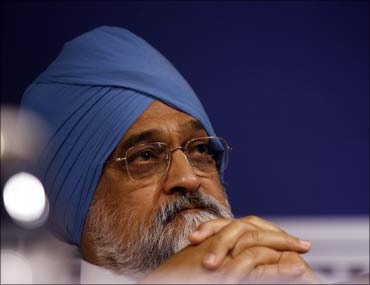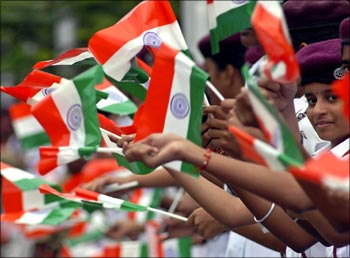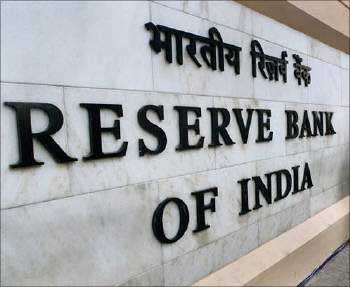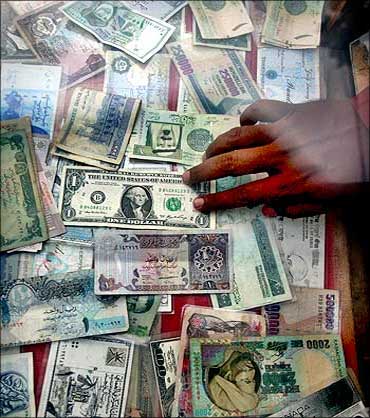
How serious was Planning Commission Deputy Chairman Montek Singh Ahluwalia when he said that India was not after non resident Indian funds or NRI money?
At the annual Pravasi Bharatiya Divas, organised by the government ostensibly to celebrate the country's connection with the 27-million-strong Indian diaspora living in 150 countries, Mr Ahluwalia said last Sunday that India was reaching out to NRIs not for their money, but because it valued the long, socio-cultural footprint all Indians living in India and abroad shared.
Elaborating further, Mr Ahluwalia said more than 95 per cent of investments in the country came from domestic sources and added that NRIs were, of course, welcome to invest in India if they felt that their money was well-spent in this country.
As a way of connecting with the large NRI community living in different countries, Mr Ahluwalia's attempt may well work.
. . .

However, there is a larger disconnect in the manner in which he tried to contextualise the relationship between the NRI community and India.
It is, of course, true that NRI investments in projects in India have remained quite small over the years.
Since 1991, when the country liberalised its foreign investment policy, NRIs have accounted for a total foreign direct investment of $179 billion, which is less than 2 per cent of the total such investment India has received from different countries.
However, irrespective of whether Mr Ahluwalia likes it or not, India's dependence on NRI money has increased over the last few years.
And to gauge that dependence, a simple measurement of the NRI share in India's total FDI is clearly not the appropriate tool.
Consider, for instance, the rising level of remittances by the NRIs, expressed largely as private transfers in the government's balance of payments data.
. . .

In 1990-91, NRI remittances were about $2 billion. In 2009-10, they were $52 billion and in the first six months of 2010-11, they had reached a level of $26 billion, maintaining the tempo witnessed in the last few years.
The criticality of the remittances becomes evident in two ways.
One, NRI remittances in 1990-91 accounted for a little less than 1 per cent of India's gross domestic product or gross domestic product.
Last year, these remittances became close to 4 per cent of GDP.
India is still far from being a remittances-dependent economy like Bangladesh, but the rise is unmistakable.
Remittances are also a function of the attractiveness of the domestic economy and ease of policies that facilitate such transfers.
. . .

If the government reverses these policies or the Indian economy becomes weak, the flow of remittances too may slow down.
Two, India's balance of payments has reached a level where a decline in remittances can cause a problem.
In 2009-10, for instance, the net surplus on the external account was only $13 billion.
If the remittances that year, estimated at $52 billion, had been lower by 25 per cent, that surplus would have simply vanished.
The short point is India's balance of payments is now dependent more on capital flows from foreign institutional investors and NRI remittances than ever before.
Therefore, notwithstanding what Mr Ahluwalia said, the reality was that the Indian economy was becoming more dependent on NRI remittances.
. . .

And if NRIs decided not to remit their savings, for whatever reasons, the Indian government would have something more serious to worry about.
It would also appear that even the NRI community does not equally share Mr Ahluwalia's euphoria over the socio-cultural connect that, according to him, drives the relationship between the Indian diaspora and India.
The NRI community has no illusions about making investments in India.
If they are sending billions of dollars back home through remittances, it is because there is need to do so.
Moreover, the environment and stability in India make such remittances attractive and even remunerative in every way.
That this commercial sense drives them becomes obvious through the pattern of NRI deposits -- the other route through which the Indian diaspora can keep their savings in India and earn a reasonable rate of interest.
. . .

NRI deposits in India have shrunk whenever there has been a crisis domestically or globally. NRI deposits dropped from $1.5 billion in 1990-91 to $290 million in 1991-92 in the wake of India's worst balance of payments crisis.
Again in 1998-99, NRI deposits shrunk to $961 million, compared to $1.1 billion in 1997-98 and $3.3 billion in 1996-97 -- all because of the East Asian crisis and India's economic crisis in the wake of Pokhran-II.
What is clear from this is that the NRI community always invests in India purely on commercial considerations, which is perhaps what it should be.
. . .

The problem will arise if we allow the euphoria over building socio-cultural bondage with the NRI community cloud the practical economic logic that drives that relationship.
The chief ministers, present at the Pravasi Bharatiya Divas, understood it quite well.
They made no secret of their open invitation to the NRIs to invest in India and earn attractive returns.
Given the current state of the Indian economy, we do need NRI money and we should make sure through sound and prudent economic policies that they find it worthwhile to remit their money to India or keep their money invested in India.
They should need India as much as India should need them.
There is neither any scope nor any need to gloat over building this relationship based on socio-cultural bondages.